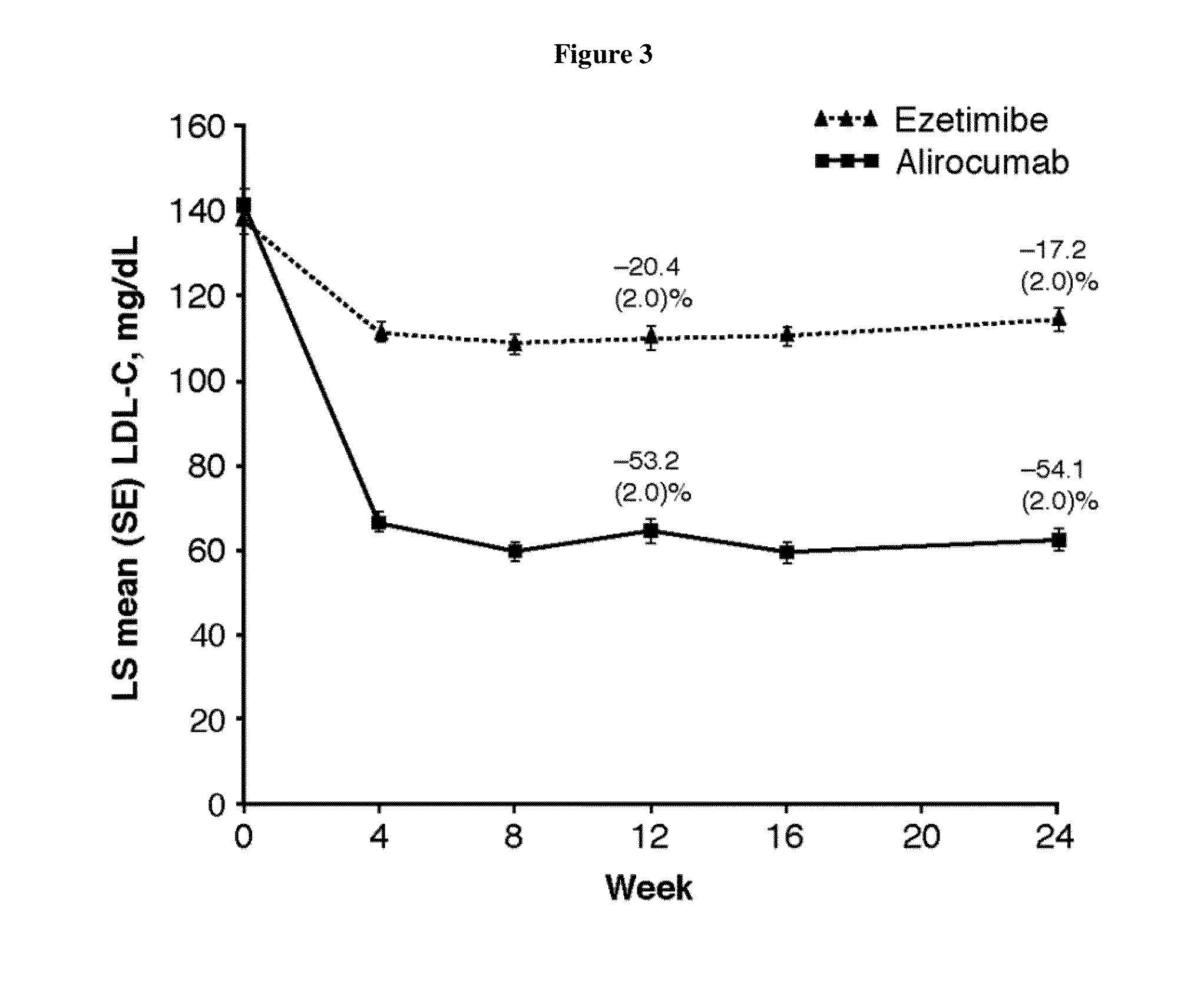Use of a pcsk9 inhibitor to treat hyperlipidemia
a pcsk9 inhibitor and hyperlipidemia technology, applied in the field of pcsk9 inhibitors, to achieve the effect of improving the serum levels of one or more lipid components, reducing the patient's low density lipoprotein cholesterol, and reducing the patient's apolipoprotein b
- Summary
- Abstract
- Description
- Claims
- Application Information
AI Technical Summary
Benefits of technology
Problems solved by technology
Method used
Image
Examples
example 1
Generation of Human Antibodies to Human PCSK9
[0157]Human anti-PCSK9 antibodies were generated as described in U.S. Pat. No. 8,062,640. The exemplary PCSK9 inhibitor used in the following Example is the human anti-PCSK9 antibody designated “mAb316P,” also known as “REGN727,” or “alirocumab.” mAb316P has the following amino acid sequence characteristics: a heavy chain comprising SEQ ID NO:5 and a light chain comprising SEQ ID NO:9; a heavy chain variable region (HCVR) comprising SEQ ID NO:1 and a light chain variable domain (LCVR) comprising SEQ ID NO:6; a heavy chain complementarity determining region 1 (HCDR1) comprising SEQ ID NO:2, a HCDR2 comprising SEQ ID NO:3, a HCDR3 comprising SEQ ID NO:4, a light chain complementarity determining region 1 (LCDR1) comprising SEQ ID NO:7, a LCDR2 comprising SEQ ID NO:8 and a LCDR3 comprising SEQ ID NO:10.
example 2
Monotherapy with an Anti-PCSK9 Antibody (“mAb316P”) Versus Ezetimibe in Patients with Hypercholesterolemia: Results of a 24 Week, Double-Blind, Randomized Phase 3 Trial
Background
[0158]Hypercholesterolemia, particularly an increase in low-density lipoprotein cholesterol (LDL-C) levels, constitutes a major risk for the development of atherosclerosis and CHD, the leading cause of death and disability in the Western world. LDL-C is identified as the primary target of cholesterol lowering therapy and is accepted as a valid surrogate endpoint. Numerous studies have demonstrated that reducing LDL-C levels mainly via 3-hydroxy-3-methyl-glutaryl-CoA reductase (HMG CoA) inhibition with statin, reduces the risk of CHD, with a strong direct relationship between LDL-C levels and CHD events; for each 1 mmol / L (˜40 mg / dL) reduction in LDL-C, cardiovascular disease (CVD) mortality and morbidity is lowered by 22%.
[0159]Three Phase 1 studies have been conducted with mAb316P and evaluated the safety, ...
example 3
A Randomized, Double-Blind Study of the Efficacy and Safety of an Anti-PCSK9 Antibody (“mAb316P”) in Patients with Primary Hypercholesterolemia Who are Intolerant to Statins
Introduction
[0342]The objective of the present study was to evaluate the ability of an anti-PCSK9 antibody (“mAb316P,” also known as REGN727 or alirocumab) to reduce LDL-C in comparison with ezetimibe (EZE) in patients with primary hypercholesterolemia (heFH and non-FH) who are intolerant to statins.
[0343]Muscle-related symptoms in clinical trials, which involve highly selected patient groups with high treatment adherence and statin tolerance, may not reflect the true prevalence of myalgia in the clinic, as evidenced by findings in observational studies. The discrepancy of the incidence of muscle-related adverse events (AEs) may be secondary to some patients experiencing AEs with multiple medications, and this may not represent true intolerance to statins. Therefore, to account for patients who may have AEs on mu...
PUM
| Property | Measurement | Unit |
|---|---|---|
| density | aaaaa | aaaaa |
| density | aaaaa | aaaaa |
| concentration | aaaaa | aaaaa |
Abstract
Description
Claims
Application Information
 Login to View More
Login to View More - R&D
- Intellectual Property
- Life Sciences
- Materials
- Tech Scout
- Unparalleled Data Quality
- Higher Quality Content
- 60% Fewer Hallucinations
Browse by: Latest US Patents, China's latest patents, Technical Efficacy Thesaurus, Application Domain, Technology Topic, Popular Technical Reports.
© 2025 PatSnap. All rights reserved.Legal|Privacy policy|Modern Slavery Act Transparency Statement|Sitemap|About US| Contact US: help@patsnap.com



